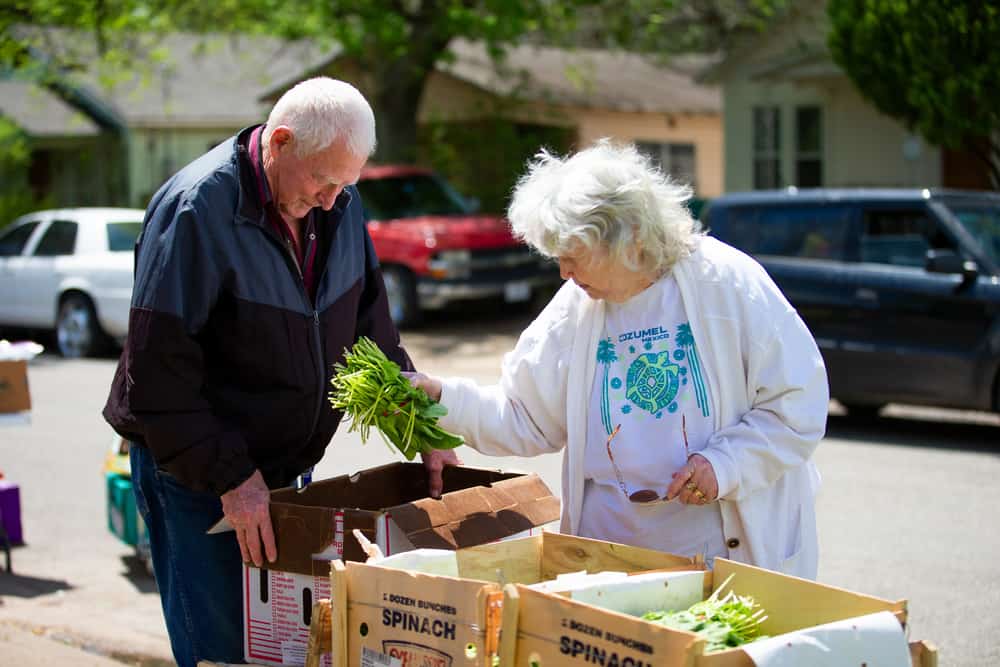Are you reading this article in a public place? Then look around you, and consider that one in seven people has to deal with hunger regularly. As such, there’s a good chance that at least a few people near you right now don’t have enough to eat.
Furthermore, they may be too ashamed of their current circumstances to go get items from a food bank or ask for assistance from those close to them.
This is where a community food pantry can be invaluable: for getting food to those in need without them losing dignity or self-respect.
What is a Community Food Pantry?
A community food pantry is an accessible area that’s dedicated to providing food to local people who may be dealing with hunger and food insecurity.
The idea behind a community food pantry is that local individuals are invited to take what they need and/or leave donations when they can, without judgment or potential embarrassment.
In an era when food security is dwindling by the day, and food banks are overwhelmed by demand, these types of shared pantries can fill in the gaps and make an immense difference in people’s lives.
Recent studies estimate that 25% of Americans (or 1 in 4 people) struggle with food security. That’s approximately 34 million people, 9 million of whom are children.
If you have kids, consider that at least a couple of children who are in class with your little ones have to go to school hungry on a daily basis.
A child dealing with the gnawing ache of hunger in their belly will have difficulty focusing on their school work, resulting in slipping grades and an uncertain future. Similarly, a parent who sacrifices their own meal to feed their child may be too hungry to work effectively, thus risking their job.
As you can imagine, a community food pantry can do more good than most people imagine. If you have the time and energy to establish one in your vicinity, know that you’d be improving the lives of everyone who uses it.
Tips for Establishing a Food Pantry in Your Area
If you’re interested in creating a community food pantry, there are many different factors to take into consideration.
Additionally, there are ways to go about establishing one that work better than others. The tips below can help you decide how to go about creating yours and how to make this endeavor a successful one.
Talk to Your Neighbors
This is a perfect opportunity to talk to those who live nearby and to get to know neighbors you aren’t familiar with yet. Start by chatting with people whom you already know, as they can introduce you to their social circles.
Listen more than you speak, and pay attention to people’s stories. They might take a while to open up to you, but neighborhood gossip is invaluable for finding out about people’s struggles.
If you find that folks are hesitant to open up and talk to you about these things, consider holding a potluck or afternoon tea. Nothing gets tongues wagging like free snacks and beverages.
Once people have started to warm up to one another and speak more freely, you can broach the subject of a community food pantry and get their input on it.
Elders, in particular, may have a wealth of advice to share, as they have a lot more life experience under their belts. They’ll have an idea of what’ll work, what won’t, what difficulties may arise, and how to work your way around them!
Identify Your Community’s Needs
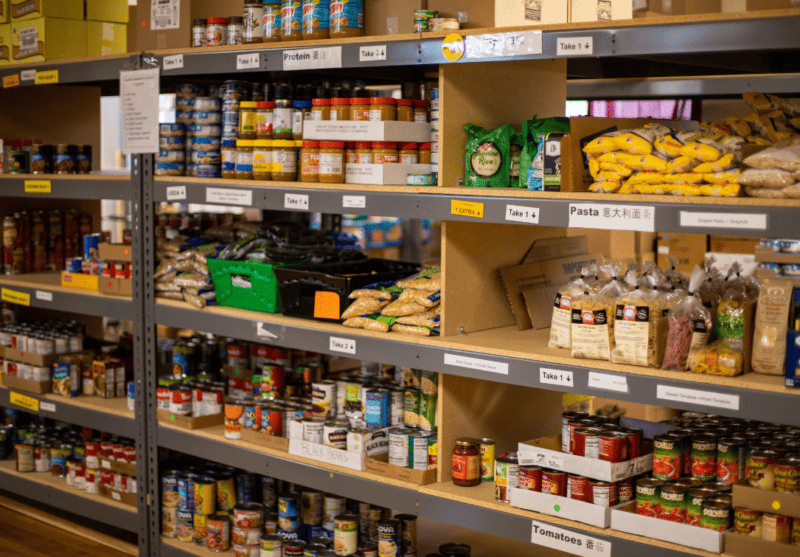
Once you’ve chatted with several community members, you’ll have a stronger idea of how to best serve those around you.
Are there a lot of children in your neighborhood? Or elderly people struggling with limited pension funds? Additionally, find out about food preferences or limitations: there are few things more devastating than being hungry and finding out that the food bank has nothing for you to eat.
Larger food banks are often unkind and judgmental towards those who appear to be “picky eaters.” Those who adhere to a particular diet because of personal ethics or religious beliefs are often told to set their beliefs aside to feed their bodies.
Similarly, those whose food allergies are inflammatory rather than anaphylactic are encouraged to “take what they can get” since eating just a little bit “isn’t a big deal.”
People with Crohn’s, celiac disease, and other autoimmune conditions would beg to differ, as ingesting even a small amount of inflammatory foods can make them sick for months, forcing them to miss work and intensifying their food insecurity.
Similarly, severely disabled people who need to be fed via tubes have specialized dietary requirements.
Also, take into consideration that the people who will be taking advantage of the pantry’s offerings may not be fluent in the area’s primary language.
If this is the case, try to identify the most common languages spoken by your neighbors and have labels, notices, and other information available in those tongues. It’s terrible to be hungry but unable to identify the foods offered to you.
As mentioned earlier, it’s only by talking to members of your community that you’ll be able to identify—and thus support—their unique needs.
Set Up a Committee

If and when you get the go-ahead from the majority of your neighbors to get a community food pantry sorted, you’ll need to sort out a committee. This will be a small, tightly-knit group of people who can work together to keep the pantry working efficiently.
Life happens, and the pantry must remain functional even if a few people are down with illnesses, injuries, work commitments, family issues, etc.
Having a committee means that there’s a group of folks to count on to deal with anything that may arise, and can also be available to a wider community.
The ideal committee will have members from several different groups for the sake of equal representation, as well as overall comfort for everyone involved.
For example, people who may not speak the majority language would be more comfortable communicating with someone on the committee board who speaks their tongue and knows their culture well.
Similarly, people of different age groups are often more comfortable speaking with their peers.
One of the most successful community food pantry committees I worked with was a perfect example of this kind of cross-section. The committee members ranged in age from 19 to 80, and represented all the major cultural backgrounds in the community.
It was a perfect example of the positivity that people are able to achieve when they work together.
Establish Policies and Procedures
Talk to your committee about which policies and procedures need to be set in place.
For example, you can decide as a group whether there are items that are unacceptable for donation, such as home-baked goods or items that can potentially set off severe allergies.
Additionally, you’ll need to figure out procedures on how to deal with possible setbacks and issues. These may include (but are not limited to):
- Who to contact for cleanup in the case of spilled or leaking items
- Who’s responsible for adding dates to donated items (i.e. is it the donor’s responsibility to write the donation date with a Sharpie? Or is it one of the committee members?)
- Who has copies of permits and any other legal documents
- Emergency contacts in case of allergic reactions, injuries, etc.
- Protocols for intentional damage, vandalism/theft, etc.
It’s also good to have regular meetings—either monthly or quarterly—to go over what’s working and what isn’t. For example, you may find that there are items in the pantry that are consistently passed over in favor of others, which end up being in shorter supply.
As an aside, note that some places are more litigious than others, and you may encounter the occasional bad egg who tries to capitalize on your good deeds.
In order to protect yourself against potential charges or lawsuits, consider posting a notice (possibly in several languages, depending on your community) in which you make it clear that no staff members, volunteers, or property owners/managers are responsible if anyone gets ill or injured from food bank uses.
Everyone is using the community food pantry willingly, and it’s up to them to be discerning about what they take and how they use it, as well as keeping the area safe and clean for everyone.
With this kind of disclaimer, you can’t be held responsible if someone chooses an item that throws them into anaphylactic shock. It’s a “caveat emptor” situation and encourages folks to use common sense and decency towards one another.
Find an Accessible Location
One of the most important aspects of your community food pantry should be accessibility. After all, the entire goal here is to make food available in an empowering and respectful manner. As such, there are a number of different factors that need to be taken into consideration.
First and foremost, this location will depend on what type of community you live in. For example, many apartment buildings have unused storage rooms on the main floor or in the basement.
Talk to your building’s superintendent about the possibility of transforming that into a community pantry. Alternatively, if you’re establishing a shared pantry in your community, you’ll need to find a locale that has both parking options and is accessible by public transit.
Key aspects of your pantry should include:
- Open access: People should be able to enter the pantry without asking permission or being given a key. As such, it should be unlocked and accessible to the public 24/7 or have set hours during the day/week so people can come and go as they please.
- A request list: Leave a notebook or clipboard with a pen or pencil so people can write down what they’re looking for—either anonymously or with their contact info so they can be given a heads-up when and if it becomes available.
Be sure to check out zoning laws and permissions in your area! It may be wonderful if someone who has an accessible garage offers to let you use it for your pantry, but you may end up being fined if zoning laws are strict.
Familiarize yourself with the Good Samaritan Food Donation Act, as well as any regional legislation that may apply.
If you’re in a small community, or if you can’t find a large zone, you can always set up a small locker or closet type of thing in someone’s front yard. This is like one of those “little free libraries,” but has food and necessities instead of books.
Set Up Shelving
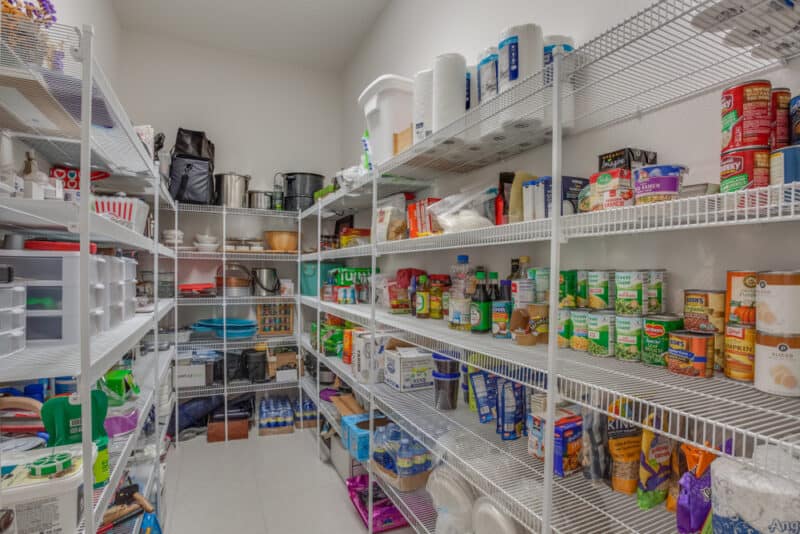
If you’re lucky, the room or building you’ve chosen for your community food pantry will already have shelves available for you to stock. The more likely scenario, however, is that you’ll need to either source or build shelves to house your items.
Check out social media marketplaces and donation sites to see what may be available. A lot of people give shelving away when they remodel their garage or basement, or if they clear out a relative’s house to sell.
Aim for thick, strong wooden or metal shelving rather than anything too flimsy: particle board may be cheap and easy to clean, but it won’t be able to support a significant amount of canned goods.
Talk to your committee about how you’re going to arrange the items within it. For example, are you going to store fruits and vegetables all in one section, canned soups in another, etc.?
Or do you think it’s better to group various ethnic ingredients together?
You can also mix and match in that regard, so people will know that they can find any kind of canned bean in that particular section, but that there’s also a designated shelf where they’ll find familiar spices, sauces, and special ingredients.
If you’re going to offer refrigerated items as well, you’ll need to have a fridge/freezer in the pantry that’s in good working order. It’ll need to be cleaned out by volunteers on a regular basis to ensure that nothing is rotting at the back and receive regular maintenance.
Secure Donations and Establish Partnerships
Depending on the community you’re in and what the local needs are, donations can come in a wide variety of forms.
For example, if one of your methods of combating food insecurity involves tending a large community garden, you can approach companies that donate seeds to such initiatives.
In contrast, if you’re setting up a pantry in an apartment building, you can ask for permission to put up notices in public areas, such as near the mailboxes or in the lobby.
Make it known to residents that they’re encouraged to participate in this initiative, and let everyone know what kinds of donations are accepted. This will give them a good what to donate when and if they have a surplus and what will be available when they’re in need.
If there are wealthy patrons in the area, they may also be open to sponsoring or making regular donations to your community food pantry.
This may involve quarterly shopping trips to bulk places like Costco to get items to share, or giving your committee an allowance to keep things stocked.
Alternatively, you may be able to make an arrangement with a local farmer’s market or grocery store: if they know that they aren’t going to be able to sell items by their “best before” date, they may be willing to donate those items to you instead of tossing them into the garbage.
Stock Your Shelves
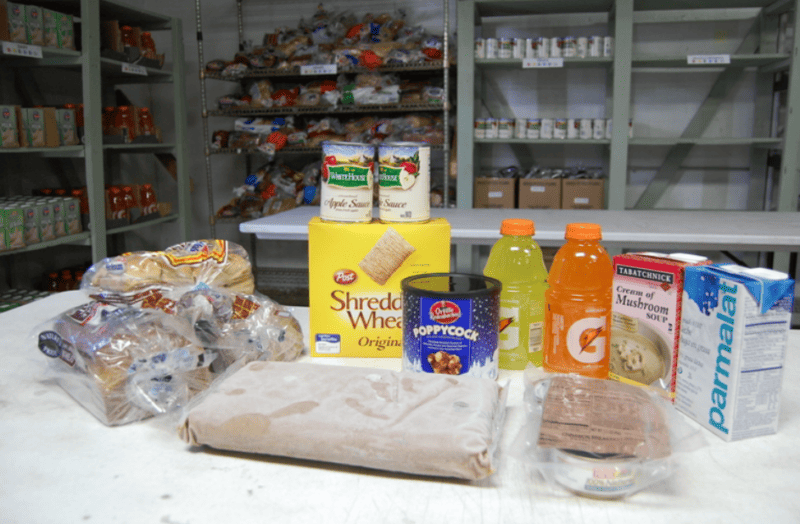
Once you’ve set up shelving and gotten donations, it’s time to stock those community food pantry shelves.
You don’t have to have a mountain of goods to start with: you can begin with whatever you have available. It’s okay if the shelves seem sparse to start with, as they’ll fill up faster than you can imagine. As word spreads and people stop by to check it out, donations start to pile up.
One great way to stock this pantry is to keep a donation jar next to the request list we mentioned earlier. People are welcome to toss spare change into it when they stop by, and once those coins accumulate a bit, committee members can take said change and put it towards the special requests.
If nothing specific has been asked for, the money can be used to buy items on sale, especially if they seem popular with the pantry’s clients.
Keep an eye on flyers that advertise big sales, and consider also having a donation box for coupons that people may not be using. Those that offer 50% off or “buy one get one free” are ideal for increasing pantry items.
Additionally, if some committee members are willing to do so, there are a lot of companies that offer free food or personal care samples in exchange for reviews. Those samples can then be added to the pantry shelves for people in need.
Ensure Diversity with Available Options
As we touched upon earlier in the article, it’s important to take a community’s unique needs and preferences into consideration. Having basics such as flour, rice, canned vegetables, and cooking oils in your community food pantry is great, but familiar seasonings and condiments go a long way towards lightening spirits and making people feel more comfortable.
Few communities are homogenous, and you’ll undoubtedly have people of many different cultures participating in your community food pantry initiatives. ‘
As a result, aim to cater to the various culinary preferences that community members will gravitate to. Ensure that you have herbs, spices, sauces, and non-perishable items from around the world.
Additionally, try to make it a priority to have special items available. People may not “need” chocolate cake mix, pudding cups, good coffee, or coconut cream, but they certainly make life worth living. Furthermore, having delicious, luxury comfort food can make an excruciating situation a little more bearable.
Consider reading the article entitled “Poor People Deserve to Taste Something Other than Shame.” It encompasses exactly why it’s so important to have options besides bread and water to keep those in need alive for another day.
Consider Expanding Pantry Options

People who struggle with food insecurity often have difficulty meeting other household needs. As such, talk to your committee about the possibility of dedicating a few community food pantry shelves to household and personal items.
For example, “period poverty” is a very real issue that many struggle with when they have a limited income.
The same goes for baby care and other personal hygiene products. As such, please consider setting aside a full shelving area for these items in addition to the standard canned and dry goods. Options for this section can include:
- Personal hygiene items: menstrual products, soap, shampoo and conditioner for various hair types, toothpaste, incontinence supplies, bathroom tissue, etc.
- Baby care: diapers, wet wipes, diaper rash cream, formula, baby/toddler food
- First aid supplies: peroxide, rubbing alcohol, band-aids, antibiotic ointment
- Health supplements: vitamins, protein powder or fortified drinks, essential oils
- Cleaning supplies: dish soap, laundry detergent, spray cleaners, microfiber or paper towels, bleach
- Gardening supplies: seeds, soil, fertilizer, and pots for those who’d like to grow items on their own patios or balconies
Give Everyone a Chance to Get to Know One Another
Consider having a “pantry cleanup party” a couple of times a year, in which items that haven’t moved off the shelves are transformed into tasty potluck fare. You can expand the culinary options by partnering with a local food bank or firehouse and invite the entire community to a cookout.
This is an excellent opportunity to get to know those in the neighborhood you’re serving. It also allows people to give input and feedback about the pantry. Some patrons may have experience with similar initiatives and have valuable suggestions.
Others may volunteer to pick up donations from shops around town that cater to specific cultural cuisines. You’d be amazed at the friendships that can develop when people come together for a common goal, and just how much can be achieved through unity and generosity.
Have Trust
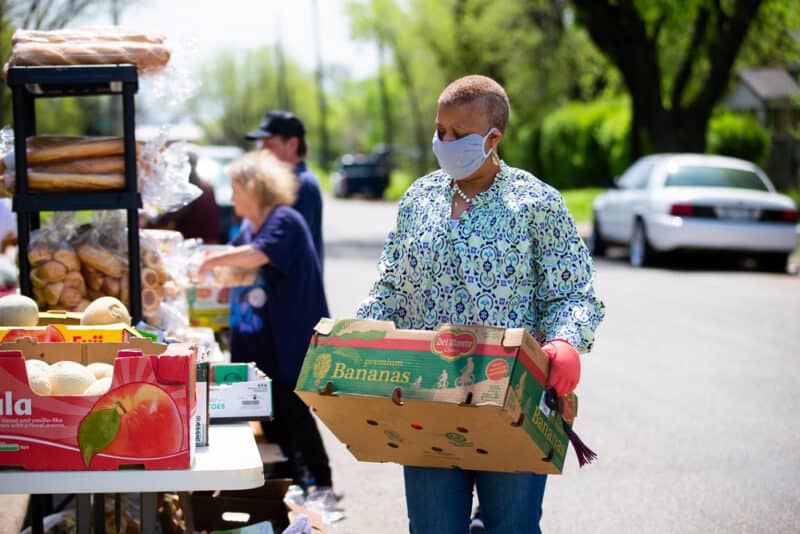
A lot of folks feel wary about establishing a community food pantry because they feel that they have to police or micromanage it somehow. This is generally unnecessary.
Those in need are often the first to share with others because they know what it’s like to go without. As a result, community members are often the best options for keeping a food bank in good working order.
Avoid using video surveillance or trying to keep track of who’s taking which items and how often. The entire point of having this available to serve the community is for the community to benefit from it.
More often than not, when you give people an opportunity to be decent and awesome, they step up. Leave a broom and dustpan in the pantry along with a garbage bin and empty bags, and it’ll be kept tidy by those who frequent it.
Knowing that there’s a resource that can help everyone in the community is a huge incentive to take care of it. Furthermore, you can often count on neighbors to not only look out for one another (and shared resources) but to also take action to reprimand or punish those who take advantage of it or vandalize it.
You can be prepared to deal with difficulty without expecting it to happen and may be pleasantly surprised to discover that your trust isn’t misplaced but instead is remarkably appreciated by your entire community.
